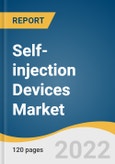The global self-injection devices market size is expected to reach USD 10.8 billion by 2030. It is projected to expand at a CAGR of 5.7% from 2022 to 2030. Increasing patient volume and rising prevalence of chronic diseases along with the high adoption of advanced drug delivery systems are factors estimated to surge the demand for self-injection devices.
Prevention of needlestick injury is a primary factor for healthcare professionals and companies to introduce self-injection devices such as autoinjectors. To avoid needlestick injuries to healthcare workers, the U.S., Europe, and other markets mandate the use of safety devices. Several auto-injectors provide the additional benefit of needlestick protection to healthcare professionals. It is expected that in the U.S. about 69,000 injuries can be prevented annually. Numerous auto-injectors have integral and passive safety features that eliminate or reduce the risk of injury.
Innovation in the field of New Drug Delivery Systems (NDDDS) has led to the rising demand for self-administered medications. The invention of novel injectable delivery devices such as pre-filled syringes, pen injectors, autoinjectors, and needle-free injectors has made the self-administration of drugs easier and more convenient for patients. The majority of biological drugs are delivered using injections, which include the threat of needlestick injuries. To minimize this issue, pharmaceutical firms are developing self-administered needle-free injectors and patient-friendly medication-device combination products.
The COVID-19 pandemic has altered expectations and perceptions of delivery settings and contributed to a rise in preference for self-administration medication. As this becomes the norm, several manufacturers are inclined to make the patient experience the vital component of drug delivery design. Significantly, the COVID-19 vaccines will increase the demand for injectable devices and the pandemic has also shown the benefit of self-use devices as well as connected devices. Post-pandemic there may be a rise in upcoming innovation in devices and pharma manufacturers will progressively collaborate to use self-injection devices in combination with other digital assets such as apps, phones, and personal computers. Eventually, this will bring the patient into far greater control of their care.
This product will be delivered within 1-3 business days.
Prevention of needlestick injury is a primary factor for healthcare professionals and companies to introduce self-injection devices such as autoinjectors. To avoid needlestick injuries to healthcare workers, the U.S., Europe, and other markets mandate the use of safety devices. Several auto-injectors provide the additional benefit of needlestick protection to healthcare professionals. It is expected that in the U.S. about 69,000 injuries can be prevented annually. Numerous auto-injectors have integral and passive safety features that eliminate or reduce the risk of injury.
Innovation in the field of New Drug Delivery Systems (NDDDS) has led to the rising demand for self-administered medications. The invention of novel injectable delivery devices such as pre-filled syringes, pen injectors, autoinjectors, and needle-free injectors has made the self-administration of drugs easier and more convenient for patients. The majority of biological drugs are delivered using injections, which include the threat of needlestick injuries. To minimize this issue, pharmaceutical firms are developing self-administered needle-free injectors and patient-friendly medication-device combination products.
The COVID-19 pandemic has altered expectations and perceptions of delivery settings and contributed to a rise in preference for self-administration medication. As this becomes the norm, several manufacturers are inclined to make the patient experience the vital component of drug delivery design. Significantly, the COVID-19 vaccines will increase the demand for injectable devices and the pandemic has also shown the benefit of self-use devices as well as connected devices. Post-pandemic there may be a rise in upcoming innovation in devices and pharma manufacturers will progressively collaborate to use self-injection devices in combination with other digital assets such as apps, phones, and personal computers. Eventually, this will bring the patient into far greater control of their care.
Self-injection Devices Market Report Highlights
- Needle-free injectors segment held the largest market share in 2021 owing to the rising demand for needle-free injectors and increased health consciousness among individuals.
- The disposable segment held a significant market share in 2021 due to the ease of use and the presence of a built-in glass syringe that reduces the necessity of manually loading the glass syringe, eventually making it more convenient for patients.
- The cancer segment is anticipated to gain the highest market share during the forecast period due to the increasing prevalence of cancer all across the globe.
- North America led the market in 2021 owing to the increasing demand for self-injection devices used for the treatment of several chronic diseases.
- The Asia Pacific region is expected to expand at the fastest CAGR during the forecast period due to the rising incidence of autoimmune diseases and high prevalence of cancer across several countries in the region.
This product will be delivered within 1-3 business days.
Table of Contents
Chapter 1. Methodology and Scope
Chapter 2. Executive Summary
Chapter 3. Self-injection Devices Market Variables, Trends & Scope
Chapter 4. Self-injection Devices: Product Estimates & Trend Analysis
Chapter 5. Self-injection Devices: Usability Estimates & Trend Analysis
Chapter 6. Self-injection Devices: Application Estimates & Trend Analysis
Chapter 7. Self-injection Devices Market: Regional Estimates & Trend Analysis
Chapter 8. Competitive Landscape
Companies Mentioned
- Ypsomed Ag.
- Bd
- Gerresheimer AG
- Antares Pharma
- Haselmeier AG
- Nugen Medical Devices
- Owen Mumford Ltd.
- Shl Medical AG
- Pfizer, Inc.
- Amgen
Methodology

LOADING...
Table Information
| Report Attribute | Details |
|---|---|
| No. of Pages | 120 |
| Published | April 2022 |
| Forecast Period | 2022 - 2030 |
| Estimated Market Value ( USD | $ 6.9 Billion |
| Forecasted Market Value ( USD | $ 10.8 Billion |
| Compound Annual Growth Rate | 5.7% |
| Regions Covered | Global |
| No. of Companies Mentioned | 10 |









